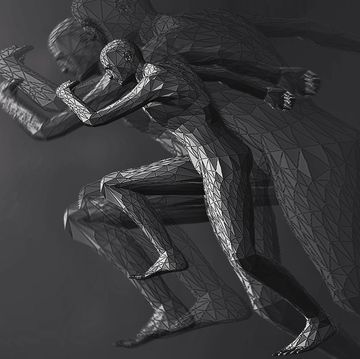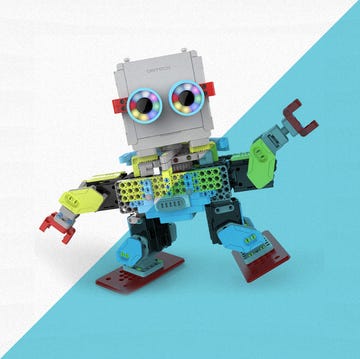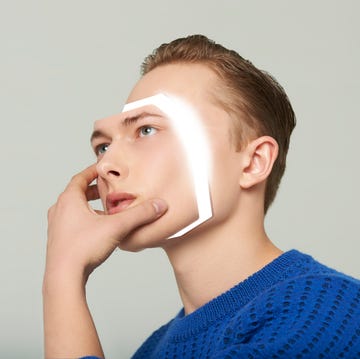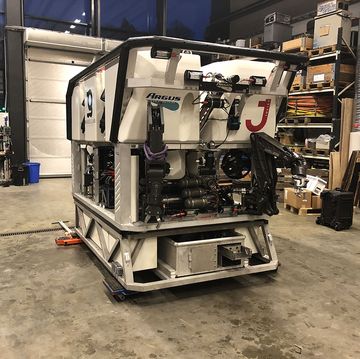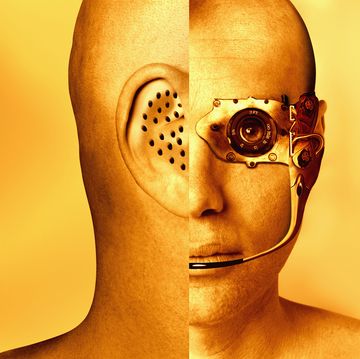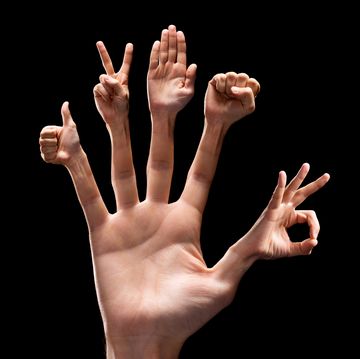As futurists, transhumanists, and journalists filed into New York's Alice Tully Hall on Saturday to hear a talk by android scientist Hiroshi Ishiguro, many were drawn to the stage to take photos of a childlike robot and the man sitting next to it. More than one audience member suspected that the man was Ishiguro himself, staring down at the floor, blinking passively and pretending to be an android. But when the real Ishiguro took the stage, it was clear that the man in the chair was actually Ishiguro's body double, the android Geminoid HI-2.
For about a decade now, Ishiguro has been experimenting with eerily humanlike robots in his lab at Osaka University in Japan. By studying the way humans and robots interact, he hopes to discover the ideal design for a robot and learn more about human nature along the way. "By building these kinds of robots, we can deeply understand humans," he said during last weekend's Global Future 2045 conference in New York City.
Ishiguro's lab uses these extremely lifelike androids to test hypotheses in neuroscience and cognitive science, because the appearance of the robot heavily influences a person's impressions and evaluations of the robot's behavior. "So far, robots have been used in engineering," Ishiguro said. "After this, robots will be used in science."
The first question for his group: How humanlike a robot should be? To investigate, the team members started by making detailed copies of real humans. Although bots such as Geminoid HI-2 don't need to move below the shoulders, the scientists realized that to make him pass as a human being, they'd have to add subtle movements to his head and shoulders.
Ishiguro's first attempts at emulating the unconscious motions a person goes through while sitting in a chair—shifting the eyes or adjusting the angle of the head, for instance—resulted in weird, zombie-like movements. Since scientists don't know what guides such fidgeting, Ishiguro's group had to measure natural human movement using a 3D motion-capture system and then translate those rules into programming for each android.
The resulting robots are strikingly lifelike, at least at first glance, and Ishiguro thinks they'll have all sorts of uses in the future. For example, when an aging priest in Japan could no longer lead his congregation in prayer, he and his son commissioned an android in his likeness to lead the prayers for him. "This is much better than video," Ishiguro said. With the android "we can feel his presence."
Hiroshi Ishiguro (right) stands next to his android body double, Geminoid HI-2 (left).
Similarly, Ishiguro has used his own android to teach classes and attend press conferences—although he jokes that the university refuses to pay the android. "Everything's there, right? My appearance and movement and talking . . . Everything is there. But, of course, he doesn't have a brain."
Are androids more human(like) than humans? "Yes, of course," Ishiguro said. "Because we can find the best appearance, the best facial expressions, and the best movement." The one thing that androids can't do very well is carry on a conversation. Ishiguro's most humanlike robots are more like silicon puppets, teleoperated by a real human who speaks for and coordinates the movement of the android.
For example, he said, after they used one of these bots to put on a play, they ran into a problem: Audience members complained that the leading android was too perfect. "My purpose is not to make her perfect. My purpose is to make her a humanlike android. So I needed to think again about human likeness. I would say the perfect android is not so humanlike." In fact, a picture of Ishiguro's earlier Repliee Q2 robot is pictured in the Wikipedia entry as a demonstration for the term uncanny valley—the hypothesis that robots that are too similar to humans actually give us the creeps.
More recently Ishiguro is moving toward minimalist designs, such as Telenoid, shown in the photo above. Humans interact with one another using imagination, and Telenoid's ageless and sexless minimalist design allows a person to imagine the android as anybody they want it to be. That's handy for anyone who can't afford to commission a $100,000 android copy of themselves, and Ishiguro says they help to transfer the "presence" of distant friends and family members.
"The soul is everywhere in Japan," Ishiguro says. "My question is, why are humans so special? I don't see the clear boundary between [humans and androids]. Sometimes androids are much better."
In fact, it was the android who had the last word that day. As the talk ended, Geminoid HI-2 complimented Ishiguro on his talk but said he needed to practice more at public speaking. "Next time, I will give you a much better presentation," the android said.



